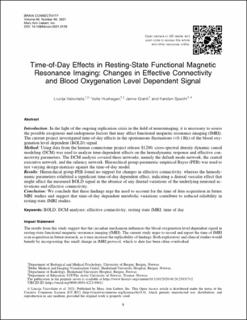| dc.contributor.author | Vaisvilaite, Liucija | |
| dc.contributor.author | Hushagen, Vetle | |
| dc.contributor.author | Grønli, Janne | |
| dc.contributor.author | Specht, Karsten | |
| dc.date.accessioned | 2022-02-07T14:17:49Z | |
| dc.date.available | 2022-02-07T14:17:49Z | |
| dc.date.created | 2022-01-28T08:07:27Z | |
| dc.date.issued | 2021 | |
| dc.identifier.issn | 2158-0014 | |
| dc.identifier.uri | https://hdl.handle.net/11250/2977555 | |
| dc.description.abstract | Introduction: In the light of the ongoing replication crisis in the field of neuroimaging, it is necessary to assess the possible exogenous and endogenous factors that may affect functional magnetic resonance imaging (fMRI). The current project investigated time-of-day effects in the spontaneous fluctuations (<0.1 Hz) of the blood oxygenation level dependent (BOLD) signal.
Method: Using data from the human connectome project release S1200, cross-spectral density dynamic causal modeling (DCM) was used to analyze time-dependent effects on the hemodynamic response and effective connectivity parameters. The DCM analysis covered three networks, namely the default mode network, the central executive network, and the saliency network. Hierarchical group-parametric empirical Bayes (PEB) was used to test varying design-matrices against the time-of-day model.
Results: Hierarchical group-PEB found no support for changes in effective connectivity, whereas the hemodynamic parameters exhibited a significant time-of-day dependent effect, indicating a diurnal vascular effect that might affect the measured BOLD signal in the absence of any diurnal variations of the underlying neuronal activations and effective connectivity.
Conclusion: We conclude that these findings urge the need to account for the time of data acquisition in future MRI studies and suggest that time-of-day dependent metabolic variations contribute to reduced reliability in resting-state fMRI studies. | en_US |
| dc.language.iso | eng | en_US |
| dc.publisher | Mary Ann Liebert | en_US |
| dc.rights | Navngivelse 4.0 Internasjonal | * |
| dc.rights.uri | http://creativecommons.org/licenses/by/4.0/deed.no | * |
| dc.title | Time-of-Day Effects in Resting-State Functional Magnetic Resonance Imaging: Changes in Effective Connectivity and Blood Oxygenation Level Dependent Signal | en_US |
| dc.type | Journal article | en_US |
| dc.type | Peer reviewed | en_US |
| dc.description.version | publishedVersion | en_US |
| dc.rights.holder | Copyright Liucija Vaisvilaite et al. 2021 | en_US |
| cristin.ispublished | true | |
| cristin.fulltext | original | |
| cristin.qualitycode | 1 | |
| dc.identifier.doi | 10.1089/brain.2021.0129 | |
| dc.identifier.cristin | 1991928 | |
| dc.source.journal | Brain Connectivity | en_US |
| dc.identifier.citation | Brain Connectivity, 2021. | en_US |

